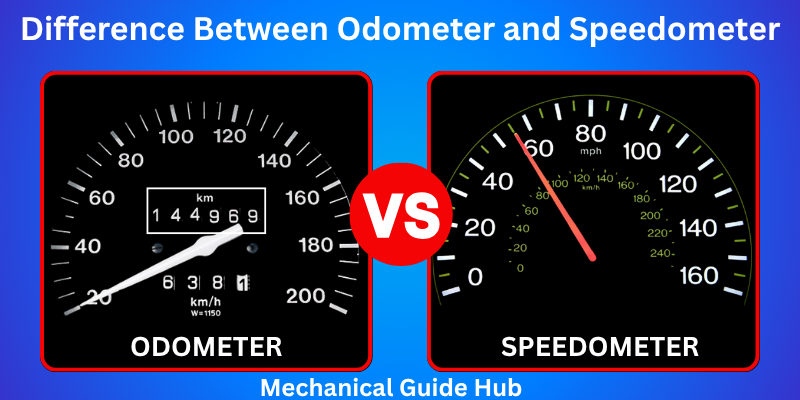Difference Between Odometer and Speedometer
Published: 24 Jul 2025

When you glance at your car’s dashboard, two prominent instruments often catch your eye: the odometer and the speedometer. Though they sit side by side and both relate to your vehicle’s movement, they provide entirely different data. Understanding the difference between odometer and speedometer is essential—not just for everyday driving, but also for safety, maintenance, insurance, and even resale value. Let’s dive into the details.
Odometer vs. Speedometer: What’s the Real Difference?
Speedometer
- It displays current speed in km/h or mph to help drivers stay within limits.
- The reading changes constantly depending on whether you accelerate, decelerate, or maintain speed.
- Helps every driver to achieve safe and legal driving speeds.
- Usually has a dial or digital screen showing numbers from 0 upwards, with a needle or digital indicator.
- Cannot and should not be reset.
- Centrally located in the instrument cluster for clear visibility.
- Uses gears and a speed cable connected to the transmission.
- Uses rotating numbered wheels.
- Crucial for obeying speed laws and avoiding fines or points on your license.
- Helps you pace your journey, ensuring timely arrival and optimized fuel usage.
Odometer
- It keeps track of how far the vehicle has traveled from the time it was first driven.
- The reading continuously increases as you drive and only resets under specific circumstances (e.g., during part replacement or with a trip meter).
- Measured in kilometres (km) or miles (mi)—depending on the region.
- Useful for scheduling service intervals, assessing vehicle wear and tear, and estimating fuel efficiency.
- Shows a set of cumulative numbers, often in a smaller digital or analog format.
- Cannot usually be reset legally; however, trip odometers can be reset to measure short distances (e.g., fuel mileage, travel segments).
- Typically placed below or inside the speedometer display.
- Uses electronic sensors and digital screens.
- Displays mileage electronically and stores data in the vehicle’s computer
- It’s usually necessary by law to provide the vehicle’s total mileage during ownership transfers or official registration.
- Used for: Service intervals, Warranty coverage, Vehicle resale value, Mileage-based insurance plans
- Helps calculate distance traveled, fuel economy, and track trips when used with a trip meter.
Conclusion
In summary, while the speedometer keeps you informed of how fast you’re going, the odometer is your vehicle’s memory of how far it has traveled. Both are fundamental instruments on your dashboard, offering distinct but complementary information. Whether you’re planning a long road trip or just keeping up with routine maintenance, understanding the difference between odometer and speedometer ensures you’re driving smart, safe, and well-informed. So next time you hit the road, take a moment to appreciate the silent work these instruments do every day.

- Be Respectful
- Stay Relevant
- Stay Positive
- True Feedback
- Encourage Discussion
- Avoid Spamming
- No Fake News
- Don't Copy-Paste
- No Personal Attacks

- Be Respectful
- Stay Relevant
- Stay Positive
- True Feedback
- Encourage Discussion
- Avoid Spamming
- No Fake News
- Don't Copy-Paste
- No Personal Attacks



